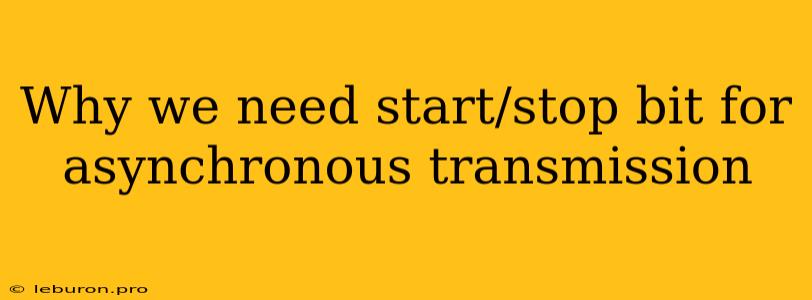Asynchronous transmission is a widely employed method in digital communication, allowing devices to exchange data without the need for a shared clock signal. This freedom from a synchronized clock provides flexibility and cost savings, making it suitable for various applications. However, one crucial element in asynchronous transmission is the start/stop bit. These special bits play a vital role in ensuring accurate data transfer by framing each data character and establishing a clear communication channel. This article will delve into the reasons why start/stop bits are indispensable for asynchronous transmission, highlighting their role in data synchronization, error detection, and overall communication reliability.
The Essence of Asynchronous Transmission
Asynchronous transmission stands in contrast to synchronous transmission, where both sender and receiver operate from a shared clock signal. In asynchronous communication, devices do not need to be synchronized to a common clock, allowing for greater flexibility and cost savings. This is particularly advantageous in scenarios where devices operate at varying speeds or when a dedicated clock signal is impractical.
However, the absence of a shared clock brings challenges in data synchronization and error detection. This is where the start/stop bits come into play, acting as essential framing elements that ensure accurate data transfer.
The Role of Start/Stop Bits in Asynchronous Transmission
Start Bit: Signaling the Beginning
The start bit, often a logic 0, marks the beginning of a character transmission. It serves as a synchronization signal, alerting the receiver that a new data character is about to arrive. By recognizing the start bit, the receiver can align its internal clock with the sender's data stream, effectively initiating the data reception process.
Stop Bit: Signaling the End
The stop bit, typically a logic 1, signifies the end of a data character. It provides a clear indication to the receiver that the current character has been fully transmitted, allowing the receiver to process the received data and prepare for the next character. The stop bit also serves as a buffer between consecutive characters, preventing potential data collisions.
Framing Data Characters
The start/stop bits are integral to framing individual data characters. They act as delimiters, defining the boundaries of each character within the data stream. This framing mechanism ensures that the receiver can accurately identify and interpret each character sent by the sender.
Error Detection: Detecting Anomalies
Although the start/stop bits do not provide direct error detection capabilities, they play an indirect role in error detection. The receiver constantly monitors the arrival of start/stop bits to ensure data continuity and proper framing. If a start/stop bit is missing or corrupted, the receiver recognizes this as an error, triggering an error-handling mechanism.
Enhancing Communication Reliability
The inclusion of start/stop bits significantly enhances the reliability of asynchronous transmission. By providing clear synchronization, framing data characters, and facilitating error detection, they ensure accurate data transfer despite the absence of a shared clock signal. This reliability is critical for various applications, particularly in situations where data integrity is paramount.
Why Start/Stop Bits Are Essential
The reasons why start/stop bits are essential in asynchronous transmission can be summarized as follows:
- Synchronization: They provide a mechanism for the receiver to synchronize its clock with the sender's data stream, ensuring accurate data reception.
- Framing: They define the boundaries of each data character, enabling the receiver to identify and interpret each character correctly.
- Error Detection: Though not a direct error detection mechanism, the presence of start/stop bits allows the receiver to detect anomalies in the data stream, contributing to overall communication reliability.
- Data Continuity: They ensure data continuity by separating consecutive characters, preventing potential data collisions.
Conclusion
Start/stop bits are an indispensable component of asynchronous transmission. Their crucial role in synchronization, framing, and indirect error detection makes them essential for reliable data transfer in environments lacking a shared clock signal. Asynchronous communication, empowered by start/stop bits, remains a vital technology, enabling flexible and cost-effective data exchange in various applications.
